Few drag racing cars have achieved the longevity, or popularity, of the Shake, Rattle, and Run 1957 Chevy. This Memorial Day Weekend, the candy-apple-red shoebox racer is set to compete at Great Lakes Dragaway in Union Grove, Wisconsin. Running 6.8-second quarter miles at over 200 miles-per-hour with pro stock driver Kevin Lawrence at the wheel, it will once again challenge the quarter mile.
The finned Chevy has been a drag strip staple since the fall of 1956, when it left the Ferrell Hicks Chevrolet dealership on Chicago’s South Side. For over six decades, it has been owned, raced, put aside, lost, and reclaimed. And Shake‘s keeper, Christopher “Dick” Messino of Chicago, has been by its side the whole way.
Dick Messino, now approaching his 82nd birthday, is no ordinary drag racer. Born into a notorious Chicago crime family, the young Messino was witness to the gambling empire run by his father, Biagio Messino, and the mob enforcement business of his uncle, Wee Willie Messino.
Dick’s ambition was to stay a step ahead of trouble while taking as big a share of the good life as possible, without fear or remorse. He didn’t choose the family trade. It was an obscenely dangerous high-stakes lifestyle bequeathed to him, and drag racing was an escape from it.
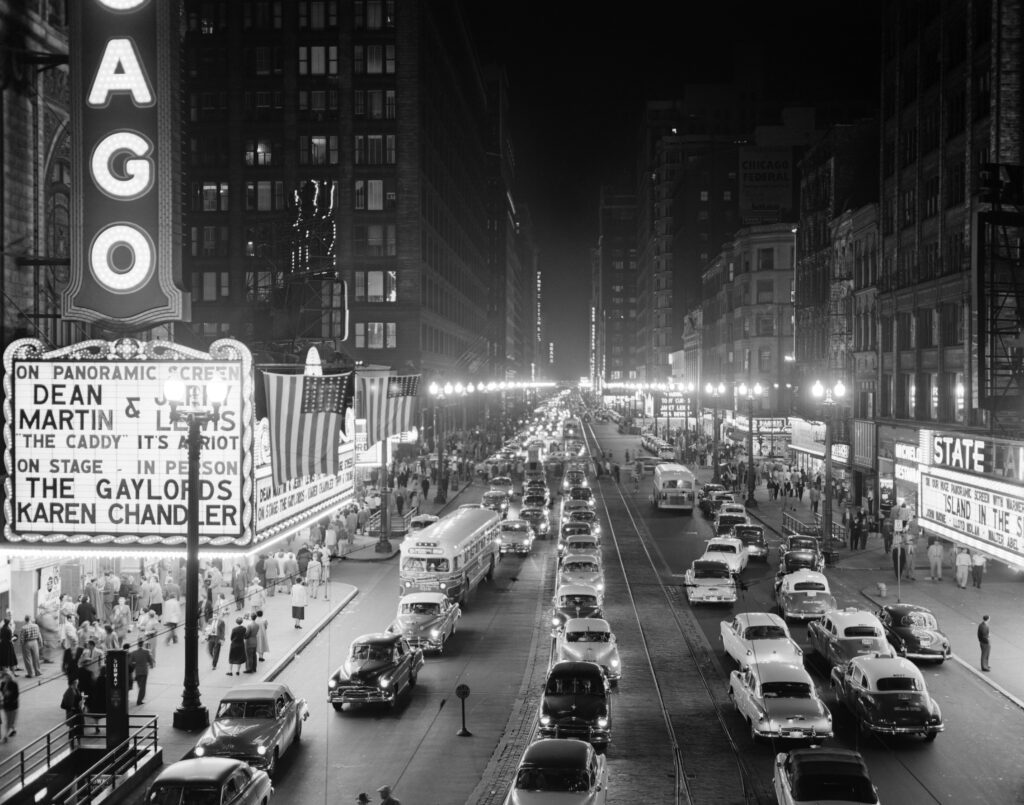
(Photo by H. Armstrong Roberts/Getty Images)
In the autumn of 1956, Dick was a junior at Chicago’s Morgan Park High School, an institution that served several blue-collar neighborhoods as well as the white-collar Beverly Hills and Morgan Park enclaves. Dick was from Mount Greenwood, a modest middle-class neighborhood on the west end of the school district. His buddy Paul Klein was the son of a wealthy Beverly resident who lived in a big house on the hill at Longwood Drive. Like many kids who come from money, he was given a new car as a high school graduation gift: a white ’57 Chevy with three-on-the-tree and a 283-cubic-inch V-8.
Soon, Klein—known to all as “CB”—and Dick were cruising the Beverly Drive-In looking for street racing action.
Even though CB and Dick came from very different families, they were both dedicated car guys. “We talked about nothing but cars and learned from each other,” said Dick. “I had picked up some mechanical knowledge of automobiles along the way. CB, too. Together, we were almost adequate wrenches.”
The Chevy was quicker than most at the Drive-In. Before long the duo wanted to see just how fast it could go, so they visited a new local drag strip just across the Indiana state line near Gary. U.S. 30 Dragway was funded by a group of civic-minded businessmen hoping to solve the street racing problem that plagued Chicago.
Dick and CB quickly found that while the ’57 seemed fast on the street, it wasn’t all that quick at the strip, so they set about making it faster. The fact that it was a brand new car didn’t enter into the equation. They stripped the bumpers and grille from the shiny Chevy, planted a fuel-injected short block under the hood, and topped it with dual quad carbs. The mods allowed the car to make 13-second runs at the nascent race track.
“By the time the Chevy was a year old, it looked like it was ten years old,” said Dick. “Then CB joined the army, and I bought the car.”
Dick realized there was good money to be made on South Side streets if you knew where to go, so he flat-towed the car to Chicago’s street racing hotbed—where Western Avenue went dark by Dan Ryan Woods and on the Calumet Expressway at 130th Street, which was largely rural back then.
Dick usually won. And when he didn’t, he would do whatever it took to get back on top, which included earning more money (by any means necessary), buying more go-fast parts, and putting in long hours under the car.
In Dick’s opinion, race cars shouldn’t be white, so he had local spray-gun guru George Little paint it red. Dick took on various partners who shared the workload and the good times on the street and strip. His gang raced in the the indoor drags at Chicago’s International Amphitheater in ’62 and ’64 where the car distinguished itself in 440-foot drags. Dick and other local shoes blasted full-throttle past indoor bleachers and decelerated through open doors to shutdown lanes in the parking lot.
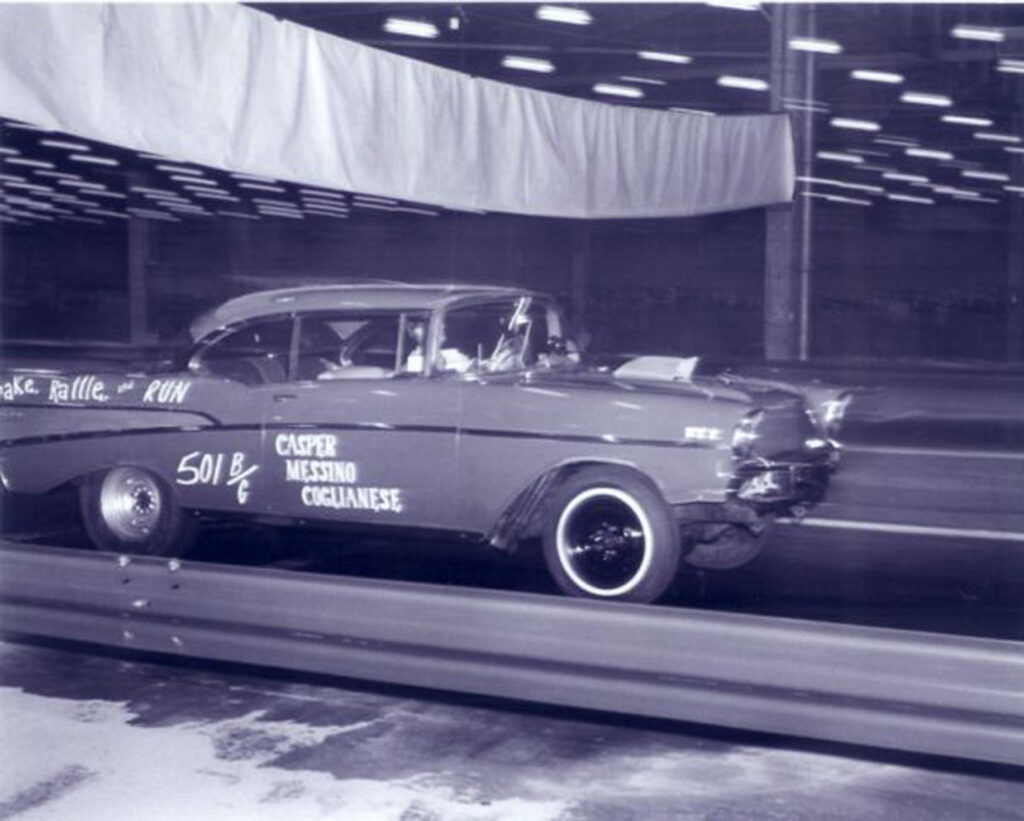
Indoor drag racing at Chicago’s long-gone International Amphitheater was a hoot, and Dick Messino and Shake, Rattle, and Run were second fastest in January 1962. (Messino Family Archives)
Although Dick drove Shake for the most part until ’63, he eventually realized he could win more consistently with a hotshot driver banging the gears, so he teamed up with racer Eric Schmidt. Schmidt drove Shake until 1969.
Dick strived to make the car quicker, too. With some work and a heavily-modified 327-cubic-inch small block under the hood, his ’57 became a top competitor in the C/Gas class.
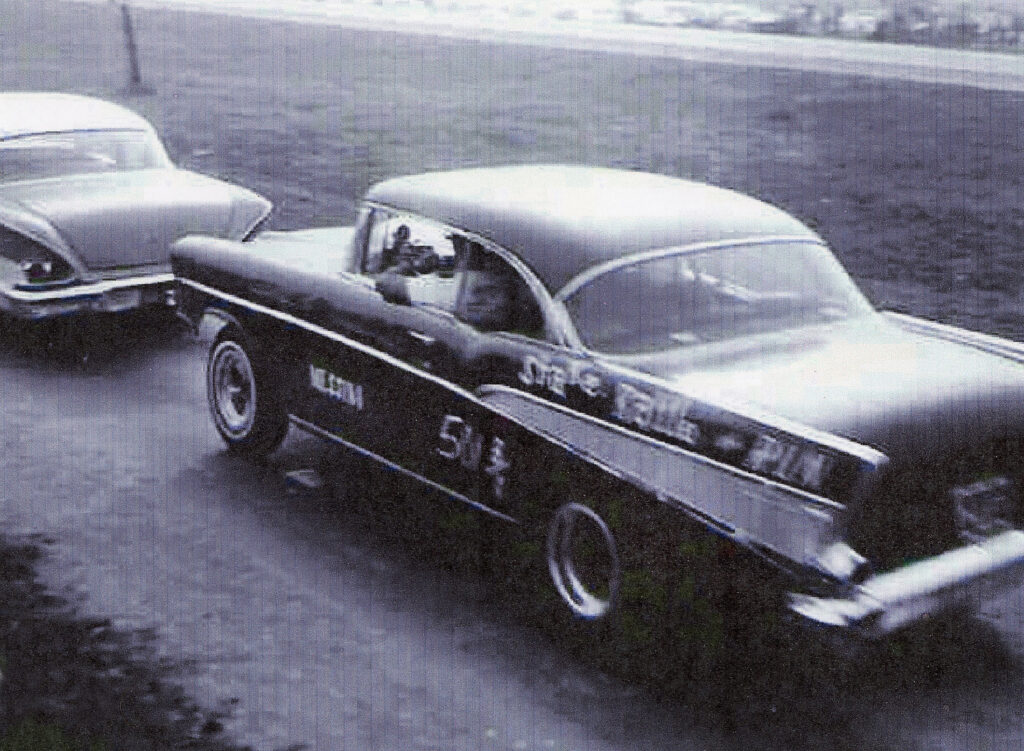
On the return road at Oswego Dragstrip in 1963. Competing in C/Gas and now equipped with a .060- over 327 cu.in. small block, the shoebox Chevy was running high 12s with Dick at the wheel. (Messino Family Archives)
Like a lot of people who grew up on the South Side back in the day, Dick saw two clear career opportunities growing up. He could be a cop or a crook. And he learned through family connections that one role could complement the other. Dick chose both. For several years, he worked as a Chicago cop and developed his own version of the Messino family business.
First and foremost, though, Dick was a drag racer.
“I never scrimped when it came to spending on the race car.” said Dick of his ’57 Chevy. I made sure we had the parts we needed. If there was something better out there, something that would make us faster, I got it.”
By 1966, a big-block engine was the hot ticket, so a Hilborn-injected 427-cubic-inch Chevy replaced Shake’s mouse motor. The old Chevy responded with 10.40-second quarter-mile pass (against a 10.70 record), making Messino and Schmidt almost unbeatable in the Street Eliminator class at Great Lakes Dragaway and Michigan’s Martin Dragway.
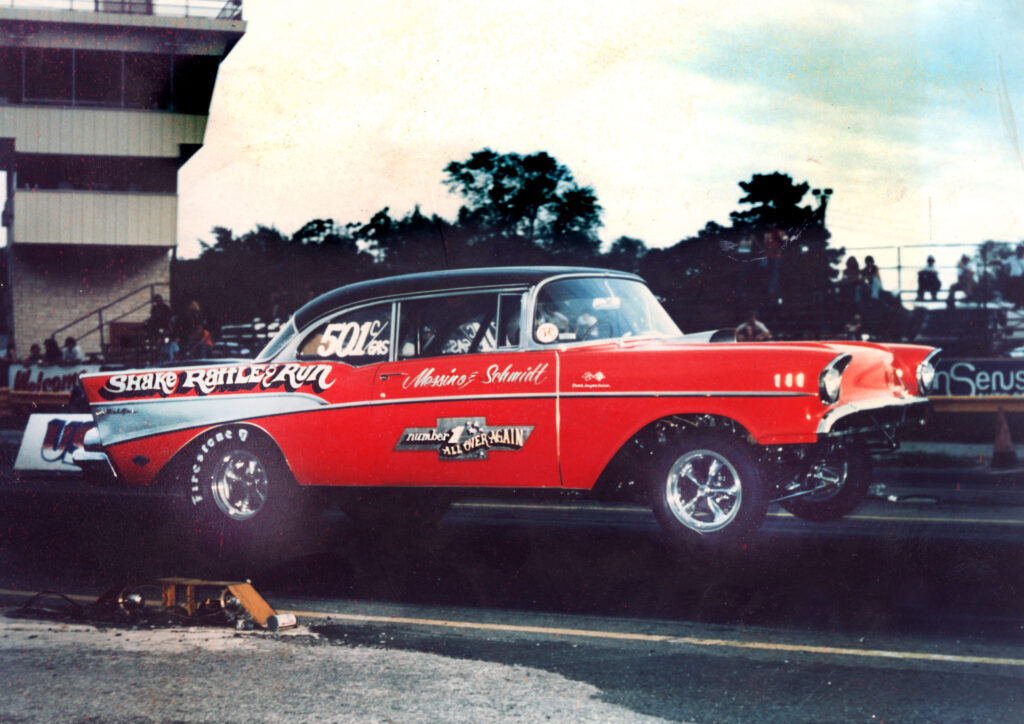
Eric Schmidt took over Shake’s hot seat in late ’63. Here, he lifts the wheels at U.S. 30 in 1968. With big block power, the car was running 10.40s in Street Eliminator. (Messino Family Archives)
It was at the Grove, in 1968, that the Chevy came close to being nothing more than a drag racing footnote. After making a pass, Shake rolled to a stop on the track. The next pair was sent off down the track before Schmidt had cleared, and the Chevy was rear ended. Hard. Both quarter panels and the rear deck lid were destroyed. The doors, the cowl with its VIN tag, and the fiberglass front end were spared, so the car was rebuilt. While Shake was in rehab, Dick became enamored of funny cars, so he parked the ’57.
Dick, in the spirit of the day, decided he ought to have a fiberglass flopper of his very own, so he built a fuel-injected Chevy II. “Erik didn’t want to drive it,” said Messino. “And I couldn’t find anyone else who could handle it.” So, after a few fits and starts, the funny car project was abandoned, and Shake was retrieved from the enclosed trailer where it spent the two years in storage.
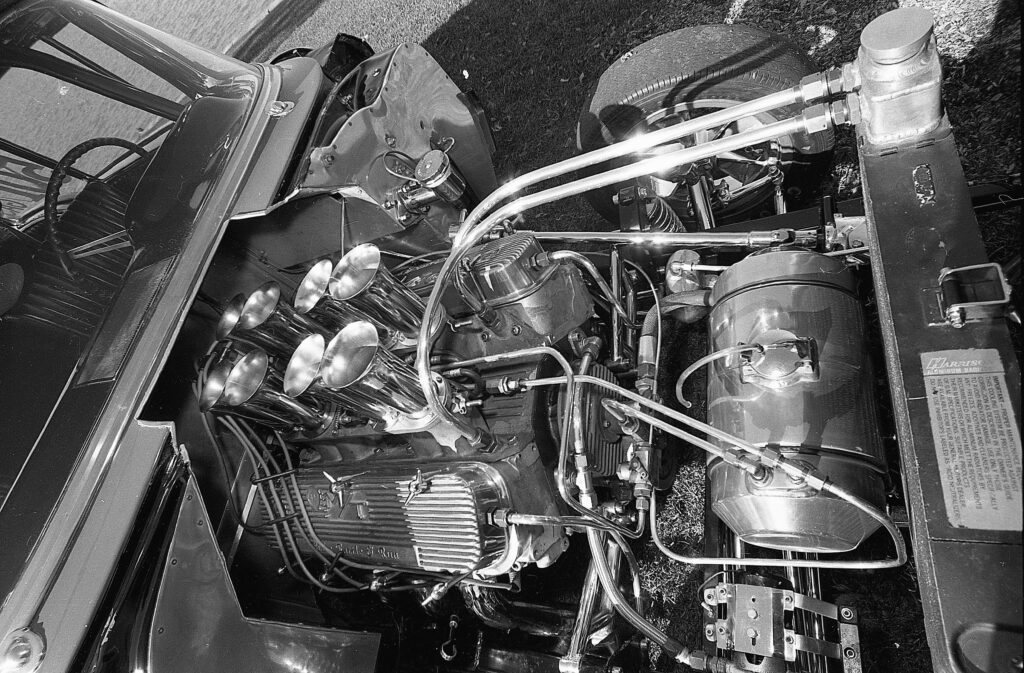
The Hilborn 468-inch big block under the flip-top front end of the 1976 Shake.
Messino sent the ’57 to R&B Automotive Engineering in Kenosha Wisconsin for a makeover. There, it got a new roll cage, four-link rear suspension, and rear tubbed wheel wells to accommodate bigger tires. “Competition Phil,” a Chicago race car painter of legend—who often worked maskless with a fifth of whiskey at his side—gave the Chevy a fabulous candy apple red paint job. Other unpainted components were coated in chrome.
Next, Dick teamed up with driver Mario Manzella. Together, they managed to push the old Chevy to an 8.93, running on a stock Chevy frame with a gasser-style straight axle up front.
A pro stock effort was also in the cards, so Mario and Dick built a Monza race car that was campaigned occasionally on the UDRA Pro Stock circuit. The Monza recorded some high seven-second efforts before crashing in Detroit. That brought the pro stock effort to an end.

It’s 1976 and Shake is running consistent 9-second elapsed times. Dick added the vinyl top in ’65 when he was doing some work at Roseland Auto Trim. It has been a Shake fixture ever since. (Messino Family Archives)
Shake, Rattle, and Run remained the love of Dick’s life, so he had a Glidden-style pro stock chassis built that would slip right in under the old Chevy body. He planted the 538-cube motor from the Monza racer under the hood, and the ’57 was once again spitting fire, turning away pretenders, and running low eights.
In 1988, Ted Borowski, an Illinois engine builder of considerable renown, told Dick he could build a 632-cube motor that would put Shake in the seven second range. Borowski was among the first to build super-size bowtie motors, and he did it with stock blocks.
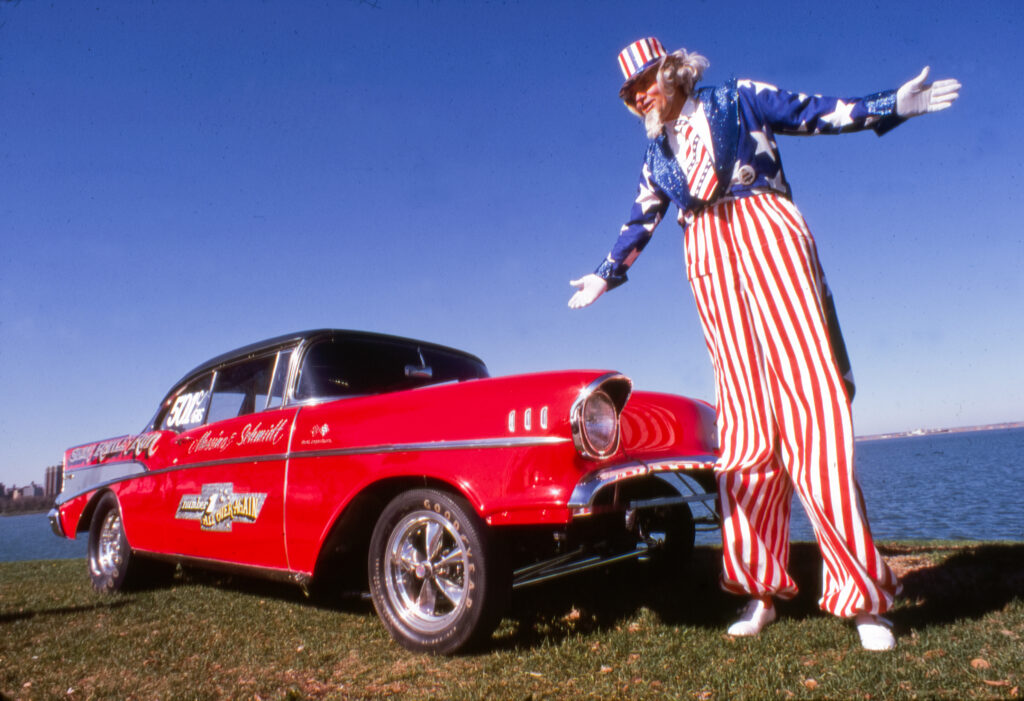
Uncle Sam on stilts dropped in on a magazine photo shoot on the shores of Lake Michigan in the bicentennial year of 1976.
Dick said, “Okay, build the motor, but you have to drive the car.” Ted became the new Shake handler and ran seven-second passes as an early Pro Mod, match racing throughout the Midwest.
Among Shake’s best remembered match races of the late 1980s are those of the “Shoebox Circuit.” The three-car traveling drag racing show featured Shake versus a Christine-lookalike ’57 Plymouth and a ’57 Ford called Mega Ford. Both were, of course, powered by stout motors and well-equipped for quarter-mile battle. Ford versus Chevy versus Mopar—the fans loved it. Running alcohol in the 632, old Shake ran 7.70-second passes and usually emerged on top.
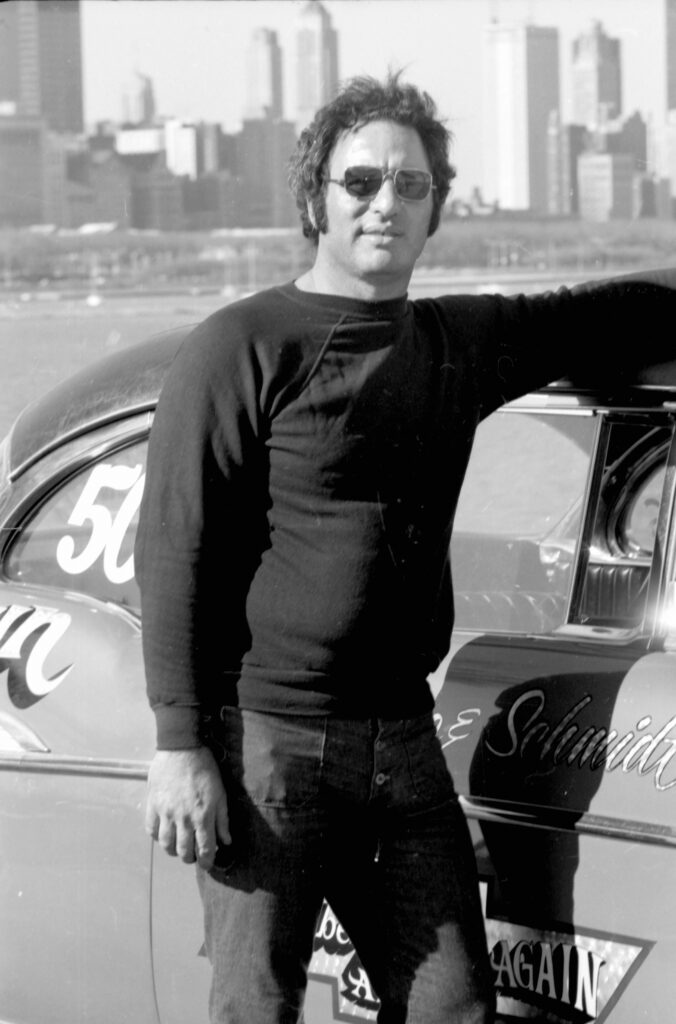
Dick Messino living fast and loose at 35 in 1976, Chicago skyline in the background. (Messino Family Archives)
Meanwhile, the dark side of Dick’s life was rapidly catching up with him. In 1993, he was arrested by Federal authorities and charged with a variety of offenses. Shake, Rattle, and Run, as well as most of Dick’s other possessions, was forfeited and packed away by the authorities. Two of his three sons were charged for their part in the family business as well. Due to a variety of legal technicalities, Dick was tried three times and served 12 years before his first conviction was overturned.
He was freed in 2005, and his belongings that weren’t sold were returned to him. Among them was the venerable ’57 Chevrolet. Despite being in the possession of the courts for 12 years, the car was intact.
“I had a different mindset after being released from prison,” said Messino. “I had grown up thinking you simply do what you gotta do to get what you want. That doesn’t work long term. Today I’m different. My friends say I’ve mellowed. I hope not too much.”
“Dick is a different guy now,” said Kevin Lawrence, who drives Shake, Rattle, and Run in competition. When I first met him back in the street racing days, he was quick to anger and aggressive. That’s gone. He has a thriving car dealership and a lot of happy customers. All completely legit.”
Lawrence helped whip Shake back into racing shape after it had been retrieved from government storage.
“It was rough from sitting so long,” said Lawrence, “and it was somewhat outdated, so Dick had it restored. Gene Pudlo of Pudlo Race Cars redid the chassis with updates for current rules, new rear suspension, engine mounts, shocks, struts, and more.”
The car was repainted and lettered. Lawrence was campaigning an NHRA pro stock, so his time was limited, but he was able to make a couple of test runs to help sort the car out.
Chicago-area shoe Mike Lopez took Shake’s wheel in 2009 and recorded the car’s first six-second pass. Lopez racked up an impressive record of match race wins over eight seasons.
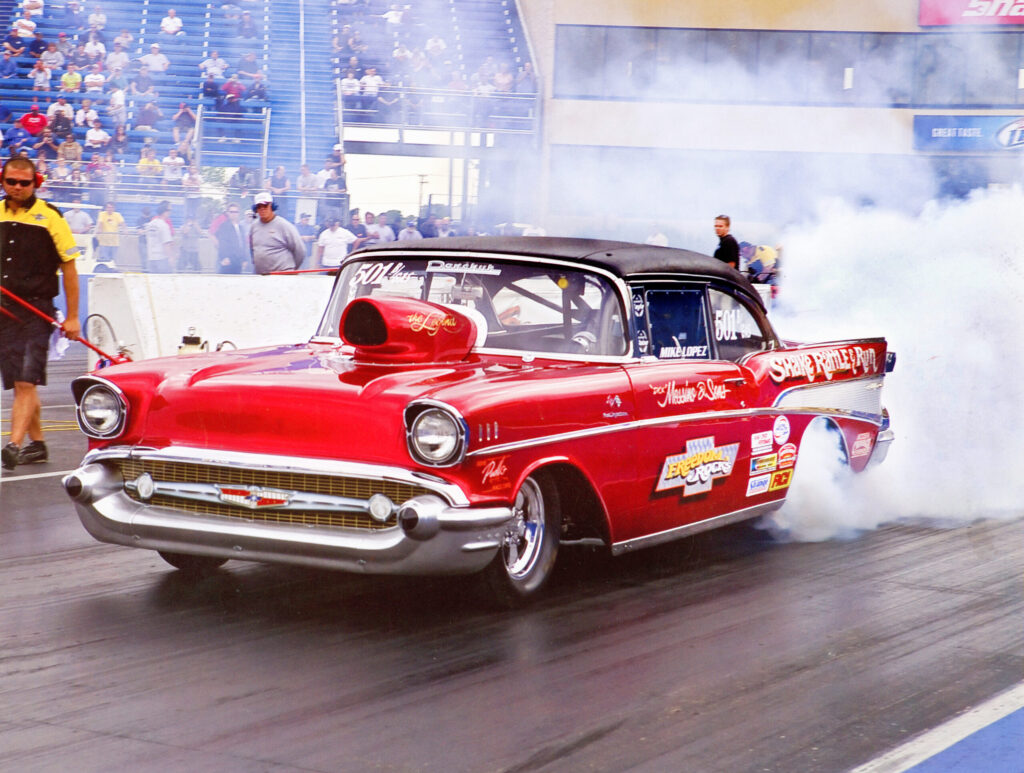
The Shake at Route 66 Raceway in Joliet, Illinois for the 2012 Lucas Oil Burndown at Sundown. Note “Freedom Rocks” on the door. (Messino Family Archives)
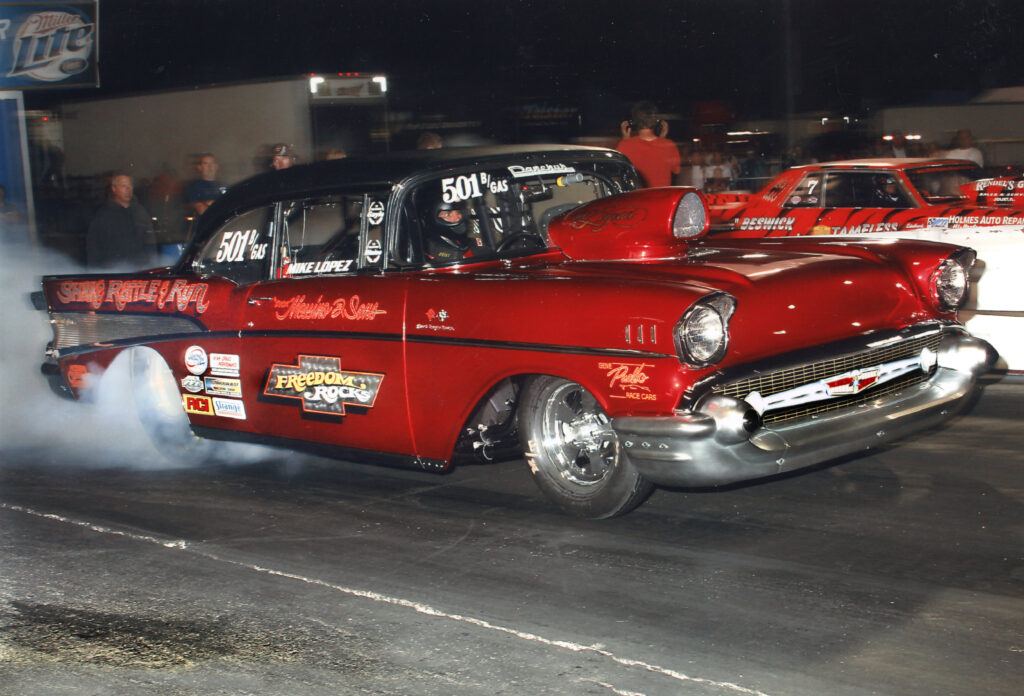
Mike Lopez in Shake takes on Arnie Beswick’s reborn Tameless Tiger in a match race at Cordova. Shake vs. Beswick was a recurring show at Midwest tracks in the teens. By 2015, Messino’s old Chevy was running in the sixes regularly and was too much for Beswick’s old Goat. (Photo by Peter Ores)
After selling his pro stock in 2017, Lawrence took a full-time turn in Shake’s cockpit, where he remains to this day. His best quarter-mile pass to date in the 66-year-old Chevy stands at 6.83 seconds at 204 mph.
Lawrence has another race car of his own. His nostalgia pro stock is a near perfect copy of Warren Johnson’s early 1990s Delco-sponsored Olds Cutlass. At some events, he drives Dick’s ’57 and his Cutlass, requiring Lawrence to hop out of one car and immediately make a pass in the other. Both have somewhat similar powertrains, and both run in the sixes at around 200 miles-per-hour on well-prepped quarter-mile tracks.
A 632-cubic-inch big-block Chevy—built by Pat Musi Racing Engines—with nitrous now provides the power for Shake, Rattle, and Run. Lawrence, who builds his own motors for the Olds, runs a similar 622-inch big-block Chevy. Lawrence says that with all that displacement, both engines only have to rev to about 8000 rpm to make good power. Both are durable power sources. The connecting rods and valves are replaced after 30 runs, and failures are rare.
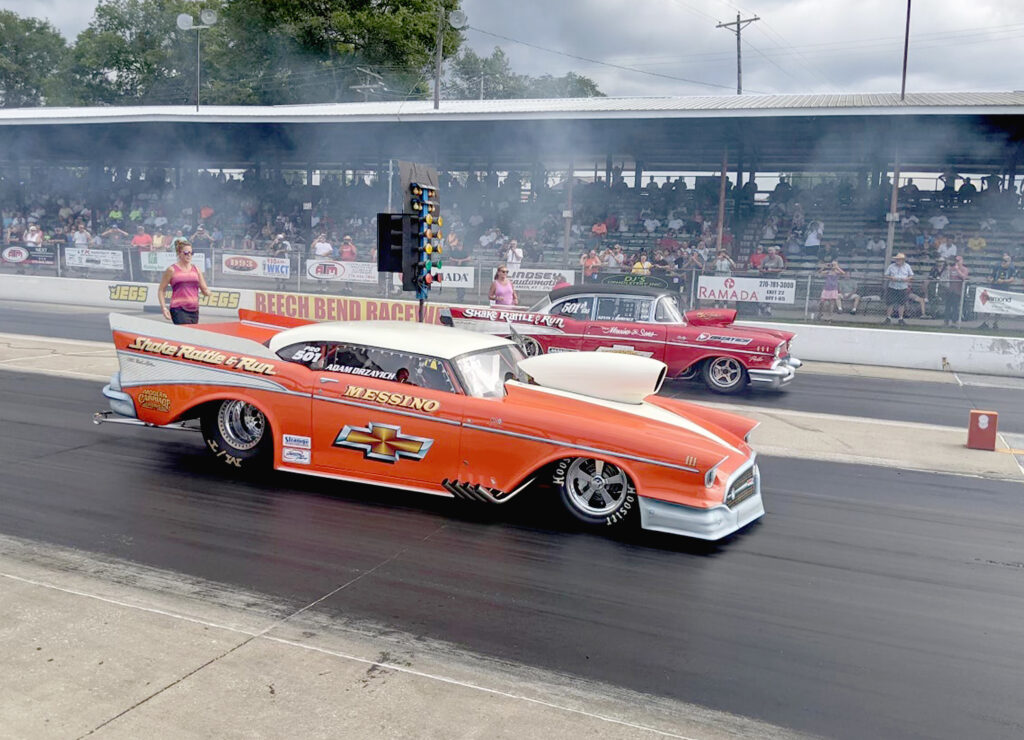
Adam Drzayich, near lane, in the Pro Mod version of Shake, takes on his father-in-law, Kevin Lawrence in the original Shake, Rattle, and Run. The lighter Pro Mod car is hundreds of pounds lighter and a couple of tenths faster, but the original red ’57 is unquestionably the star of the show. (Messino Family Archives)
As if a pair of six-second race cars aren’t enough to keep everyone busy on race day, Dick recently bought a McGinnis-built Pro Mod car topped with a sleek, streamlined fiberglass ’57 Chevy body. The car had been built for someone who realized they were in over their head after the purchase. The price was right for Dick so he jumped at it. Although it was originally built to run a supercharged engine, the car received a Steve Schmidt 632-cubic-inch big-block.
Kevin’s son-in-law, Adam Drzayich, drives it. Adam is a racing veteran and expert engine guy who tunes Kye Kelley’s car for the Street Outlaws television show. He also tunes all of Dick’s cars. Sometimes the grandkids take to the track in junior dragsters, and they’re pretty darn fast. That warms Dick’s hardened old heart and makes him smile broadly. It’s a block party at the track—multiple families, multiple generations, and multiple ’57 Chevys.
Painted orange, the newest finned coupe also wears Shake, Rattle, and Run on the doors. Compared to the original Shake, Dick’s fiberglass ’57 is lighter, slipperier, and makes faster quarter-mile passes. The new car is nice, but nothing could replace Dick’s first quarter-mile queen: a 1957 Chevrolet hailing from Chicago’s South Side.

Shake on a 6.90, 203 pass at The Grove in 2016. (Photo by Peter Ores)

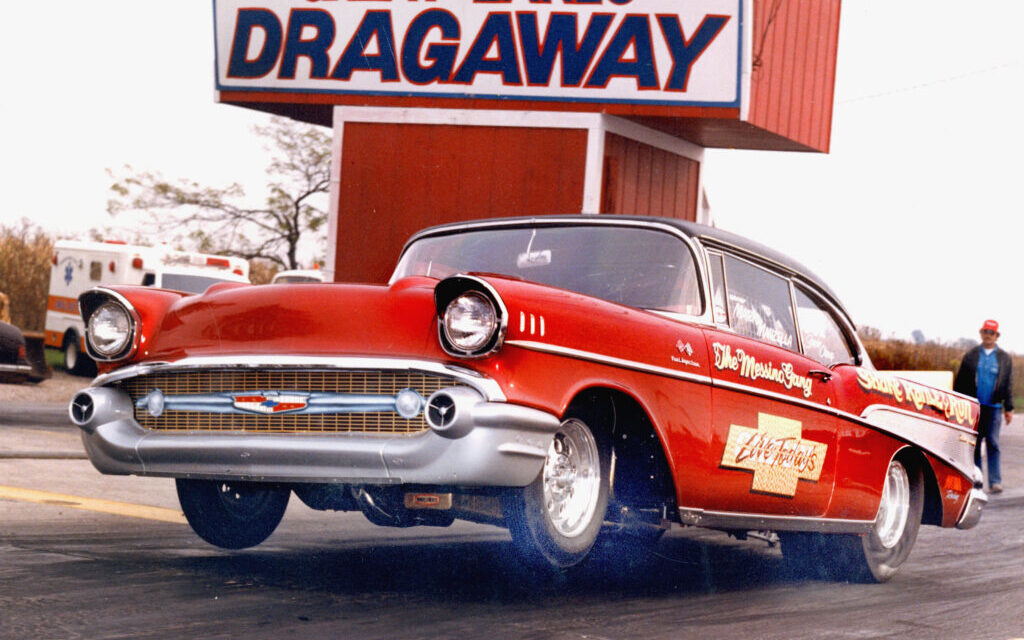
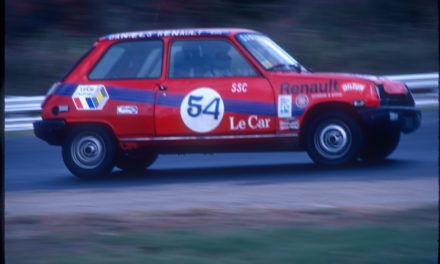
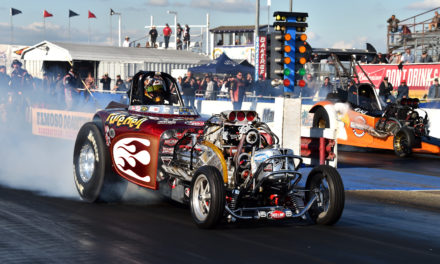
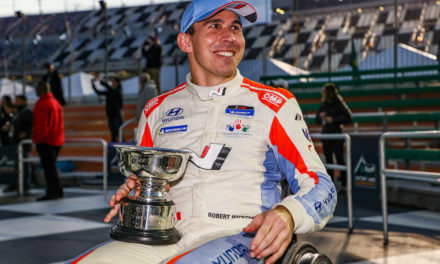
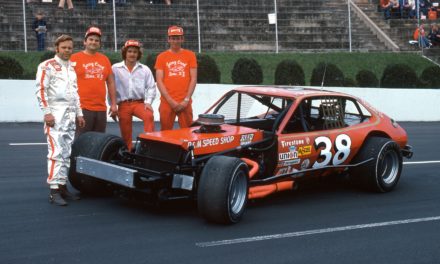
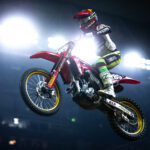
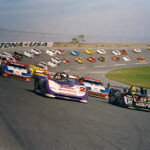
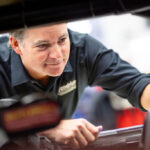
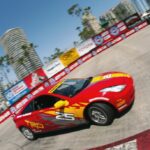
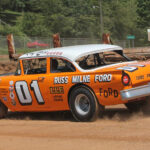
Great story. It captured the essence of both the man and his machine. I had the good fortune of meeting CB while he was in his garage working on the white Chevy. CB was a local hero to those hanging around Nick’s Pizza.